Here's how to enable or disable Scheduled Task in Windows 10. This can be helpful when you are troubleshooting some issue with the OS or apps, or when you need to pause or resume some routine activity. We will review a number of methods for doing that.
Advertisеment
Task Scheduler is a special tool which comes bundled with all modern versions of Microsoft Windows. It allows the user to schedule the launch of apps, batch files, PowerShell scripts etc after specified time intervals or when certain system events occur. The Task Scheduler has a graphical MMC version (taskschd.msc) which is the most popular tool managing tasks.
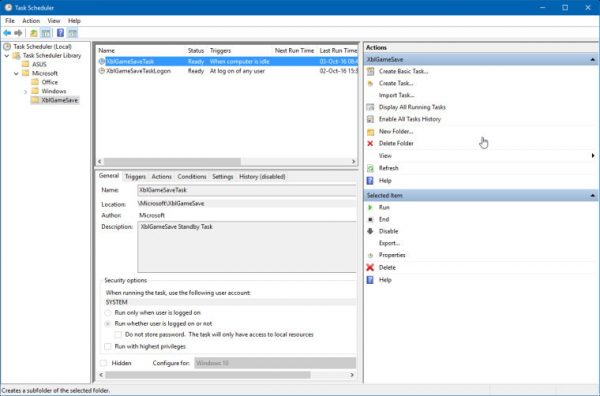
If you are not familiar with creation of tasks in Task Scheduler, we have a good tutorial here: Create elevated shortcut to skip UAC prompt in Windows 10.
This post will show you how to enable or disable Scheduled Tasks in Windows 10.
To Disable Scheduled Task in Windows 10
- Open Administrative Tools.
- Click the Task Scheduler icon.
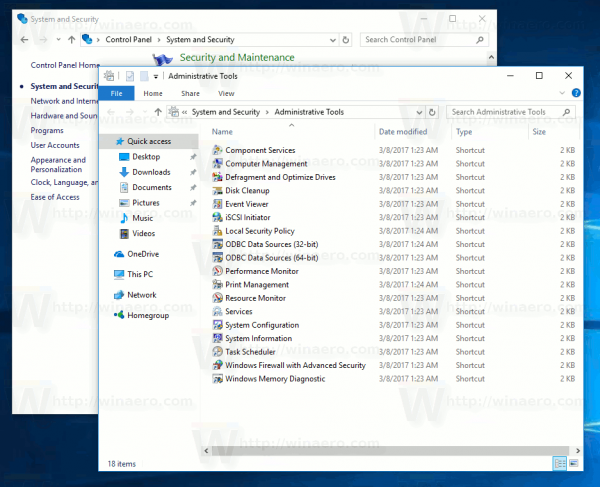
- In the Task Scheduler library, find a task you would like to disable. You may need to browse folders to find the task.
- Select the task, and click Disable in the right pane under Actions > Selected items.
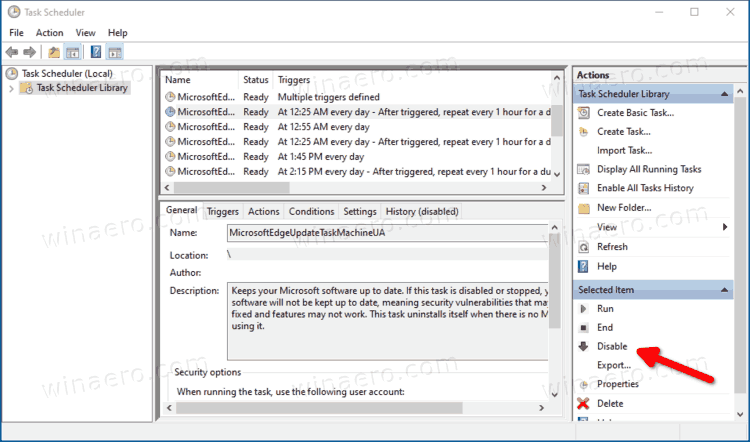
- Alternatively, you can right-click the task and select Disable from the context menu, or select Actions > Disable from the toolbar menu.
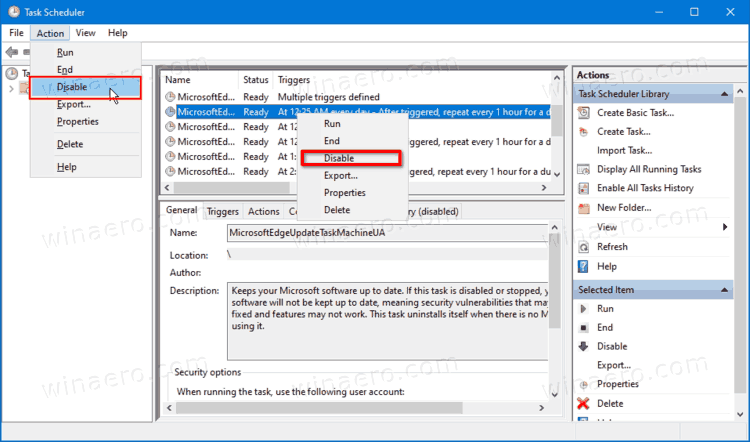
You have successfully disabled the task.
Similarly, you can enable a disabled task using the Task Scheduler GUI. Also, let's review an alternative and faster way to launch it.
How to Enable Task in Task Scheduler app
- Press Win + R to open the Run dialog.
- Type
taskschd.mscin the Run box.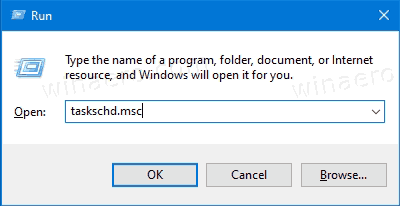
- Find the disabled task in the middle pane of Task Scheduler.
- Select it, and click on the Enable link in the right pane under Actions > Selected items.
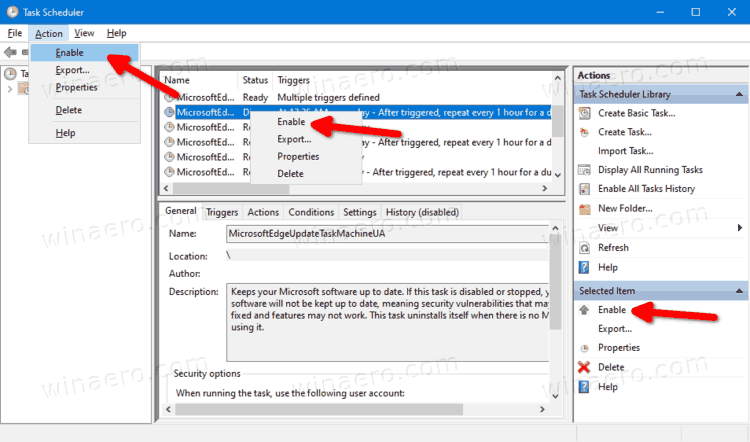
- Alternatively, select Actions > Enable from the toolbar menu, or the same option from the task right-click menu.
You have enabled the task.
Besides these GUI options, you can use PowerShell and a console tool, schtasks, to manage scheduled tasks in Windows 10. The latter is useful to various task automation scenarios.
Enable or Disable Scheduled Task in PowerShell
PowerShell includes a couple of cmdlets, Disable-ScheduledTask and Enable-ScheduledTask, that can be used to disable or enable a scheduled task in Windows 10. Both cmdlets allow specifying the full task path, so they can be used to manage tasks saved in the library root folder, and in subfolders.
Disable a scheduled task in PowerShell
- Open PowerShell as Administrator.
- To disable a task, type
Disable-ScheduledTask -TaskName "<task name>". Replace the "<task name>" portion with the actual task name you want to disable. This works for tasks created in the root of the task scheduler library. - To disable a task under some folder in the library, use the following command:
Disable-ScheduledTask -TaskPath "\<full folder path>\" -TaskName "<task name>".
- You can now close the PowerShell window.
You are done.
The same command syntax is applicable to the Enable-ScheduledTask cmdlet. Here's how you can use it for enabling a disabled task.
Enable a scheduled task with PowerShell
- Open PowerShell as Administrator.
- Type
Enable-ScheduledTask -TaskName "<task name>"to enable a disabled task. Replace the "<task name>" portion with the actual task name you want to turn on. - Similar to the above, run this command to enable a task in a folder:
Enable-ScheduledTask -TaskPath "\<full folder path>\" -TaskName "<task name>". Specify the full task path and the task name.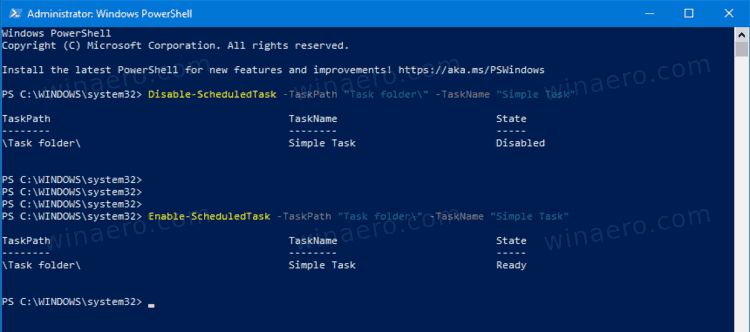
- You can now close the PowerShell window.
You are done.
Finally, let's review how to use a console tool, schtasks to disable or enable a scheduled task. You can run it in a command prompt, and also use in batch files, shortcuts, and so on. It is simple and very convenient utility.
Enable or Disable a Scheduled Task in Command Prompt
- Open a new command prompt as Administrator.
- Type the following:
schtasks /Change /TN "<task folder path>\<task name>" /Disableto disable the task. Substitute the "<task name>" portion with the appropriate task name.
- If your task is located in the root folder of the task scheduler library, you can omit the
<task folder path>\string and specify only the task name. - To enable a specific task with schtasks in the command prompt, type
schtasks /Change /TN "<task folder path>\<task name>" /Enable. Provide the full task path in the library if required, and the task name you want to enable.
- Hit the Enter key.
You are done.
It is worth mentioning that administrative privileges are not required if you want to enable or disable a task is created under your current user account in Windows 10. In this case, the task will inherit you privileges, and can be managed without escalating your access rights. This means that you can enable or disable it from a regular (non-elevated) PowerShell or command prompt. It won't require you to open the console as Administrator.
That's all about the topic.
Support us
Winaero greatly relies on your support. You can help the site keep bringing you interesting and useful content and software by using these options:
If you like this article, please share it using the buttons below. It won't take a lot from you, but it will help us grow. Thanks for your support!
Advertisеment

Hi sergey,
Just curious if a way exists to use either the powershell script variant or the cmd variant to effectively “toggle” a scheduled task as opposed to just enable or disable?
aka if it is enabled, disable it. if it is disabled, enable it?
as opposed to having two shortcuts/scripts for each task I’d like to be able to manage from my desktop persay, one for disabling and one for enabling it would be great to be able to combine them.
thanks for your awesome site/software :)
Hi.
Thanks for your kind words.
For your task, I would go with the Get-ScheduledTask cmdlet.
thank you for getting me pointed in the right direction. I’ll reference that and see if i cant get something workable :)
Is there any way to automate (registry, script, group policy, etc) the enabling of task scheduler history?